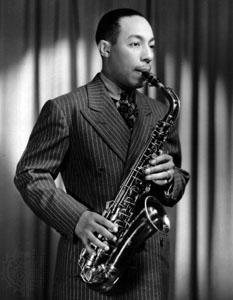Johnny Hodges (John Cornelius Hodges)

Johnny Hodges joined Duke Ellington’s orchestra in November 1928. He was one of the prominent Ellington Band members who featured in Benny Goodman’s 1938 Carnegie Hall concert. Goodman described Hodges as “by far the greatest man on alto sax that I ever heard.” Charlie Parker called him “the Lily Pons of his instrument.” Ellington’s practice of writing tunes specifically for members of his orchestra resulted in the Hodges specialties, “Confab with Rab”, “Jeep’s Blues”, “Sultry Sunset”, and “Hodge Podge”. Other songs recorded by the Ellington Orchestra which prominently feature Hodges’ smooth alto saxophone sound are “Magenta Haze”, “Prelude to a Kiss”, “Haupe” (from Anatomy of a Murder) – note also the “seductive” and hip-swaying “Flirtibird”, featuring the “irresistibly salacious tremor” by Hodges, “The Star-Crossed Lovers” from Ellington’s Such Sweet Thunder suite, “I Got It Bad (And That Ain’t Good)”, “Blood Count” and “Passion Flower”. Johnny Hodges had a pure tone and economy of melody on both the blues and ballads that won him admiration from musicians of all eras and styles, from Ben Webster and John Coltrane, who both played with him when he had his own orchestra in the 1950s, to Lawrence Welk, who featured him in an album of standards. His highly individualistic playing style, which featured the use of a wide vibrato and much sliding between slurred notes, was frequently imitated. As evidenced by the Ellington compositions named after him, he earned the nicknames Jeep and Rabbit – according to Johnny Griffin because “he looked like a rabbit, no expression on his face while he’s playing all this beautiful music.”
In the 1940s, Johnny Hodges played a Conn 6M (recognizable by its underslung neck) and later on a Buescher 400 (recognizable by its V-shaped bell-brace) alto saxophone. By the end of his career in the late 1960s, Hodges was playing a Vito LeBlanc Rationale alto (serial number 2551A), an instrument which was notable for its unusual key-mechanisms (providing various alternative fingerings) and tone-hole placement, which gave superior intonation. Fewer than 2,000 were ever made. Hodges’ Vito saxophone was silver-plated and extensively engraved on the bell, bow, body and key-cups of the instrument.Hodges’ last performances were at the Imperial Room in Toronto, less than a week before his May 11, 1970 death from a heart attack, suffered during a visit to the office of a dental surgeon. His last recordings are featured on the New Orleans Suite, which was only half-finished when he died. In Ellington’s eulogy of Johnny Hodges, he said, “Never the world’s most highly animated showman or greatest stage personality, but a tone so beautiful it sometimes brought tears to the eyes—this was Johnny Hodges. This is Johnny Hodges.”
Born
- July, 25, 1907
- USA
- Cambridge, Massachusetts
Died
- May, 11, 1970
- USA
- New York, New York
Cause of Death
- heart attack
Cemetery
- Flushing Cemetery
- Flushing, New York
- USA



